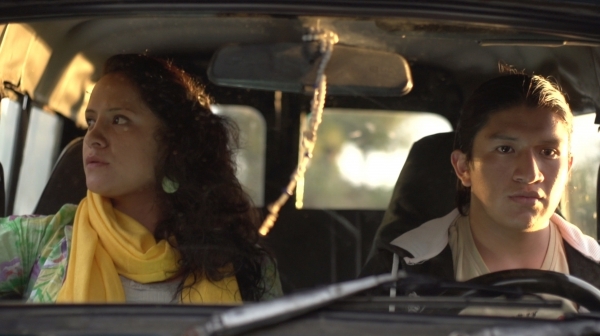BRATTLEBORO — The feature film “Vengo Volviendo” (“Here and There”) will be shown at the Latchis Theatre on Nov. 16 at 6:30 p.m., followed by a question-and-answer session with the filmmakers, Gabriel Páez and Isabel Rodas of the Ecuadorian film production company FILMARTE.
The film is in Spanish with English subtitles and is suitable for all ages.
The story follows Ismael, a 22-year-old raised by his grandmother Mariana, a midwife and skilled healer, after his parents emigrate from the Ecuadoran highlands to the U.S.
Desperate to follow in his parents' footsteps, Ismael contacts a smuggler, and he is certain of his decision to leave his homeland until his childhood friend Luz returns to their village after eight years abroad. The two criss-cross the Andes by car, meeting various characters who raise troubling questions for Ismael about his destiny.
With a haunting soundtrack and striking visuals of the Ecuadorian landscape as the backdrop to the developing relationship between the two traveling young adults, the film centers on themes of greed, exploitation, and cultural traditions, illustrated through the legends of the highlands altiplano communities.
Connection to place
Ultimately a message about connection to place and the impact of emigration on Ecuador's close-knit families, the film's subtext also examines natural-resources ownership, race, gender, and class dynamics while providing an unconventional look at the way in which Ecuadorian youth negotiate ties to cultural traditions within contemporary life.
The province of Azuay, Ecuador, the film's location, has been the core migrant-sending zone in Ecuador since the 1950s, its emigration numbers spiking as Ecuador passed through various economic crises such as the end to a booming “Panama Hat” industry, low oil prices, floods that damaged export crops and, more recently, political instability and financial mismanagement.
These resulted in devalued currency and a conversion from the national currency, the Sucre, to the U.S. dollar in 2000. Today, the region suffers from high unemployment and widespread povery. Depressed oil prices are again taking their toll across the country, and the damage from an earthquake in April has added to Ecuador's challenges.
Ecuadorian migrants, like the protagonist Ismael, joined the clandestine migration networks that led people through Central America and Mexico en route to the U.S. Husbands left behind wives and children in an effort to send home remittances for the family.
In the second quarter of 2016, these “remisas” from abroad were estimated at $669.48 million, up from $594.74 million in the first quarter, according to data from tradingeconomics.com.
In “Here and There,” one can spot the evidence of this exodus in the many images of uninhabited chalets and haunting, partially built structures, some complete with furniture wrapped in plastic, awaiting their owner's homecoming.
From the film, one might guess that these emigrants hold dear the idea of returning someday to the homes they can now afford, though the social fabric of the abandoned communities they left behind may not be recognizable.
Social and cultural relevance
Dedicated to producing and disseminating feature films with social and cultural relevance, the Ecuadorian film production company FILMARTE launched its alternative cinematographic production model in 2010.
“We used the framework of 'Encounters with Cinema' to train local youth from rural communities during a no-cost six-month artistic residency program,” explained Executive Producer Gabriel Páez. “During the six months, these individuals learned the skills needed to serve as the film's writers, actors, and technical staff.”
Prior to the film's U.S. tour, “Vengo Volviendo” was screened throughout Ecuador in commercial theaters as well as on portable screens in communities where Ecuadorians had never seen themselves represented in a feature film.
“By employing alternative training, production, and distribution methods, we hope the films can contribute to preserving the social, cultural, and oral history of Ecuadorian elders, as well as democratize access to alternative film productions that portray our own images and stories,” explained Páez, who describes how the young people working on the film were instructed to interview their elders and write up the best of their stories for inclusion in the script.
“By making films in this way, we are also giving voice to marginalized Ecuadorian young people,” Páez said, describing the empowerment of the young adults who participated as often life-changing.
The company expects to complete four feature films this decade, each in a distinct geographical region of Ecuador: the coast (“Santa Elena by Bus”), the highlands (“Vengo Volviendo”), the Amazon jungle, and the Galapagos Islands.
“Vengo Volviendo” premiered in 2016 at Rencontres du Cinema Marseille in France. It was winner of the Audience Award for Best Film in the Ecuadorian Film Festival of New York, named Best Film by the jury in the Ola Latino Film Festival in New York's Hamptons, and winner of Best Photography in the Revolution Me Film Festival in Brooklyn, New York.
It has been selected by festivals in Ecuador, the U.S., Brazil, and Chile during its first year of international distribution. Its rights were bought to be shown by American Airlines, Delta, Air Canada, and Iberia and it is appearing in numerous U.S. festivals.
